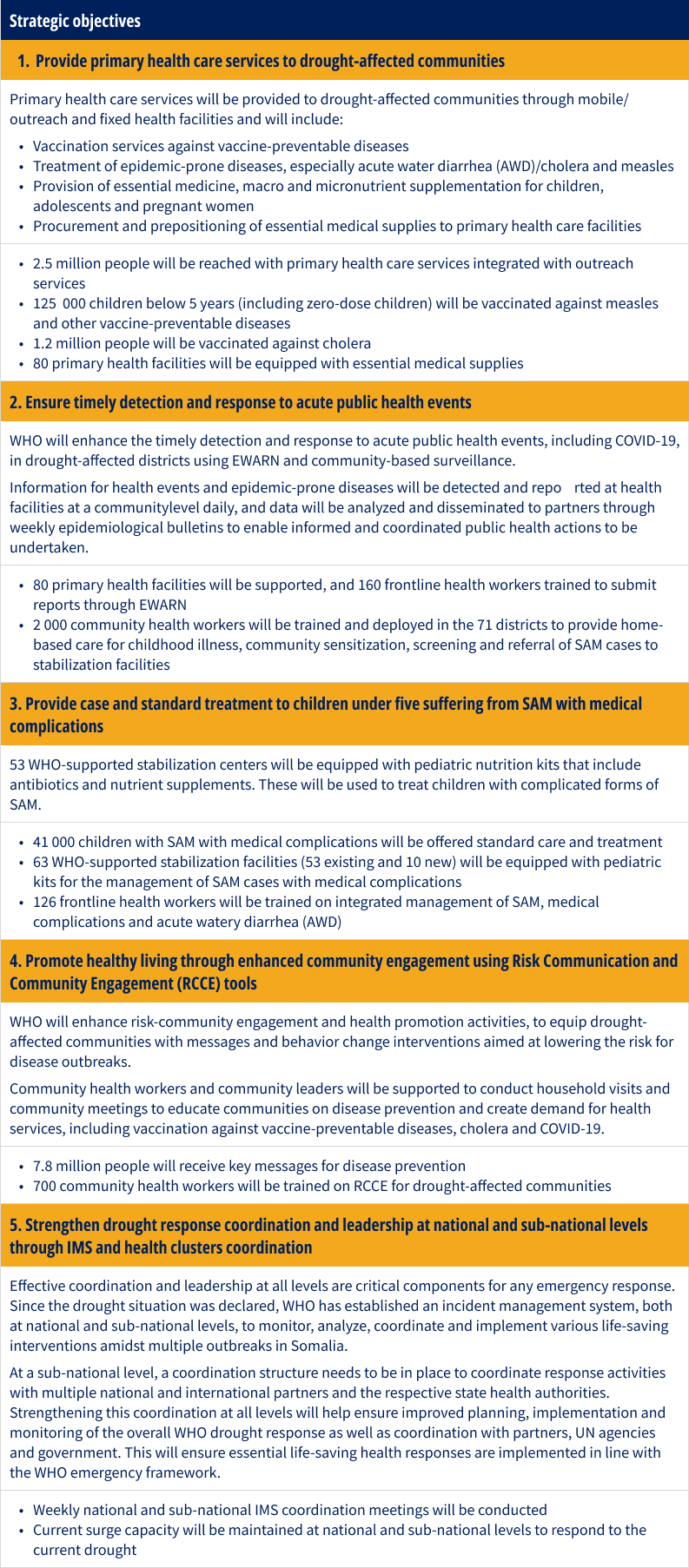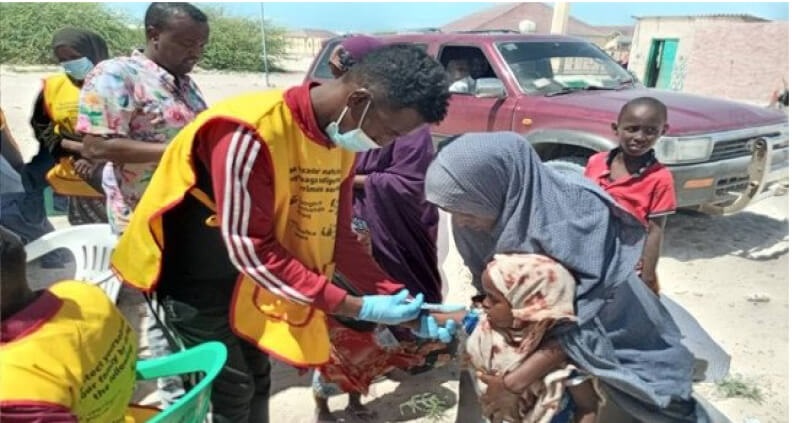
Somalia
Somalia, Grade 3 Emergency
- People in need: 7.8 million1
- People targeted: 7.6 million
- People in need of health assistance: 6.5 million
- Requirements (US$): 98.6 million
Context
Somalia is currently experiencing an escalating drought that has affected 7.8 million people and displaced 1.1 million in search of food, water and humanitarian assistance. Over 6.4 million people (38% of the total population) lack access to safe water and proper sanitation. Combined with the effects of protracted conflict and COVID-19, this has led to a weakening of the health system and higher proportions of people with limited access to primary health care services.
Between 2021 and September 2022, the number of acute watery diarrhea (AWD) cases has risen by 11% and the number of reported cholera and measles cases have increased threefold. The high incidence of measles is attributed to the low vaccination coverage which stands at 70% - significantly below the national target of 97% - leaving increasing numbers of children unvaccinated in drought-affected districts. In addition, South-central Somalia has a high number of polio zero-dose children requiring intense programmatic efforts, as the situation has the capacity to endanger the global polio eradication goal. An estimated 4.3 million people (26% of the total population) are experiencing a severe food crisis, among which 121 000 people are in the Integrated Food Security Classification (IPC) Phase 5 (Catastrophe) and 33% of children under the age of five are suffering from severe acute malnutrition (SAM) with medical complications. The lowered immunity resulting from food shortages directly contributes to an increased incidence of epidemic-prone diseases linked to drought.
WHO has strengthened community- and facility-based disease surveillance systems by deploying community health workers (CHWs) and activating the Early Warning Response Network (EWARN) – work which needs to be sustained to ensure the timely notification of epidemic-prone diseases and trigger mitigation measures. However, one issue with the provision of health and nutrition services, especially in areas where the movement of internally displaced persons (IDP) is high, remains the lack of coordination, planning and coordinated implementation among humanitarian agencies, whose numbers have increased in 2022.
Emergency response
WHO, in collaboration with the Ministry of Health (MoH), UN partners and health clusters, has mapped out high-risk populations affected by the current drought in four states: Jubaland, South West, Hirshabelle, Galmudug and Banadir region. WHO, UNICEF and WFP have jointly developed a rapid response mechanism strategy aimed at providing primary health care services to drought-affected communities across inaccessible areas in 25 districts, whereby WHO offers a minimum health package, UNICEF provides WASH services and WFP provides food and cash handouts to targeted communities. To date, WHO has already managed to reach out to 15 out of the 25 inaccessible districts with health care services and will continue to support health workers to conduct weekly outreach sessions to provide integrated primary health services to drought-affected communities. WHO will also procure medical and laboratory supplies and medical kits and distribute them to health facilities and outreach teams.
WHO has deployed CHWs in 71 drought-affected districts and is educating communities on disease prevention; screening and referral of children with SAM to therapeutic treatment and stabilization centers; conducting home-based management for diarrhea using oral rehydration solutions (ORS); and creating demand for vaccination. Weekly epidemiological data will be collected through EWARN and community-based surveillance mechanisms, then analyzed and disseminated to health partners to help plan, implement and monitor public health interventions.
At the national level, the incident management system (IMS) will lead the implementation and monitoring of the health response, in line with the WHO emergency response framework, and will coordinate with the health, nutrition and WASH clusters to ensure the best synchronization with the UN drought response plan and the Humanitarian Response Plan. At the sub-national level, WHO will establish and/or strengthen the state-based health, nutrition and WASH clusters to ensure activities are carried out in a coordinated manner under the guidance and supervision of the national IMS.
WHO is working in South-central Somalia to reach polio zero-dose children, by concentrating technical capacity and support on those areas with the highest proportion of underreached children and communities.
Strategic objectives


Key activities
- Support health facilities to conduct integrated (health and nutrition) outreach sessions to treat cases of communicable and non-communicable diseases, and to conduct vaccination campaigns against cholera, measles and other vaccine-preventable diseases, including COVID-19
- Procure and distribute essential medical supplies to health facilities in drought-affected districts, as well as pediatric nutrition kits for the management of SAM with medical complications. Support care and treatment of SAM in 53 existing and 10 new stabilization facilities. Build frontline health workers’ capacity to provide quality treatment to children with SAM with medical complications.
- Provide reagents to seven state-based laboratories
- Support health facilities with airtime to submit weekly reports for reported health alerts
- Deploy CHWs to detect and report alerts of epidemic-prone diseases, and support district-based rapid response teams to investigate and validate alerts within 48 hours of notification
- Provide operational support to state-based laboratories to collect and transport biological samples to regional laboratories for analysis
- Enhance RCCE and health promotion activities in drought-affected communities
- Deploy 700 additional CHWs to conduct community education and health promotion activities
- Support community and religious leaders to conduct community awareness sessions
- Strengthen drought response coordination and leadership at national and sub-national levels through the IMS and health cluster coordination
- Support the IMS with operational costs at the national level
- Support human resource with surge capacity at national and sub-national levels
- Support the supervision, monitoring and evaluation of drought response at the national and sub-national level

A health worker administering a vaccine during an integrated outreach services session in Hobyo district of Galmudug state, Somalia. September 2022.
Funding requirements
Overall country funding requirements, including COVID-19, by pillar (US $ million)

Success stories
Providing integrated health services to hard-to-reach areas
Somalia is currently experiencing an escalating drought that has affected 7.8 million people and displaced 1.1 million in search of food, water and humanitarian assistance. Combined with the effects of protracted conflict and COVID-19, this has led to a weakening of the health system and higher proportions of people with limited access to primary health care services. Those particularly affected live in remote, hard-to-reach areas, further limiting their access to basic health care.
To improve accessibility amongst the most vulnerable populations living in hard-to-reach areas across the country, WHO Somalia has adopted an innovative approach for providing integrated health services involving the deployment of approximatively 2 000 community health workers (CHWs). CHWs have been deployed across 71 districts to conduct daily household visits, of which 15 are inaccessible.
As part of these visits, CHWs educate the communities through health messaging, raise alerts for COVID-19 and other epidemic diseases, refer and connect communities with local health facilities and track and immunize children who have missed out on routine, life-saving immunizations, including zero-dose children. Access to local health facilities, and in particular vaccination services, ensure that the most vulnerable communities can access basic care to help lead healthier lives and receive protection against easily preventable diseases that may otherwise have life-changing consequences.
CHWs also provide children and lactating and pregnant women with supplements (Vitamin A, iron and folic acid tablets) and sensitize lactating women with infant and young children feeding messages. This approach has proven very effective during the ongoing cholera and measles outbreaks in the country. Since January 2022, over 10 million people in drought-affected communities have been reached with these vital disease prevention messages.
For more information
Dr. Sk Md Mamunur Rahman Malik | Country Representative | WHO Somalia | malikm@who.int

